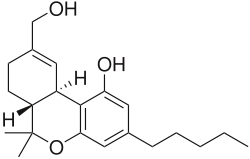11-Hydroxy-THC
 | |
 | |
| Identifiers | |
|---|---|
| |
| CAS Number |
36557-05-8 |
| PubChem (CID) | 37482 |
| ChemSpider |
34385 |
| Chemical and physical data | |
| Formula | C21H30O3 |
| Molar mass | 330.461 g/mol |
| 3D model (Jmol) | Interactive image |
| |
| |
| | |
11-Hydroxy-Δ9-tetrahydrocannabinol (11-OH-THC) is the main active metabolite of Tetrahydrocannabinol (THC) which is formed in the body after cannabis is consumed.[1] The conversion from THC to 11-OH-THC is relatively high when cannabis is consumed in the form of cannabis edibles and, compared to oral consumption, lower when it is smoked or vaped.[2] 11-OH-THC is more potent than THC and crosses the blood–brain barrier more easily.[3][4] 11-Hydroxy-THC has been shown to be active in its own right.[5][6] This might partially explain the biphasic effects of cannabis, whereby some effects such as increased appetite tend to be delayed rather than occurring immediately when the drug is consumed.[7]
Fresh cannabis contains Tetrahydrocannabinolic acid (THCA), which is converted into THC after heating and then metabolized by the body into 11-Hydroxy-THC.[8][9][10][11] Peak THC concentrations are lower after eating/drinking cannabis than after administration by smoking or vaping, but conversely, 11-OH-THC/THC ratios are higher after eating/drinking than after smoking cannabis.[12] After administration through eating or drinking, approximately equal quantities of THC and 11-OH-THC are formed, whereas 11-OH-THC is a minor constituent after administration by intravenous or smoking routes.[13] Because edible doses are processed by the liver before entering the bloodstream, THC consumed as edibles produces high levels of 11-OH-THC, while smoked cannabis, which goes directly from the lungs to the brain via the bloodstream and does not enter the liver,[14] produces lower levels.[15]
11-Hydroxy-THC is subsequently metabolised further to 11-nor-9-carboxy-THC, which is not psychoactive but might still play a role in the analgesic and anti-inflammatory effects of cannabis.
References
- ↑ Johnson JR, Jennison TA, Peat MA, Foltz RL (1984). "Stability of delta 9-tetrahydrocannabinol (THC), 11-hydroxy-THC, and 11-nor-9-carboxy-THC in blood and plasma". Journal of analytical toxicology. 8 (5): 202–4. doi:10.1093/jat/8.5.202. PMID 6094914.
- ↑ Government Marijuana Researcher Speaks Favorably About Marijuana's Medical Utility NORML September 26, 1996.
- ↑ Possible hepatotoxicity of chronic marijuana usage Sao Paulo Med. J. vol.122 no.3 São Paulo May 2004.
- ↑ Possible hepatotoxicity of chronic marijuana usage Sao Paulo Med. J. vol.122 no.3 São Paulo May 2004.
- ↑ Turkanis SA, Karler R (1988). "Changes in neurotransmitter release at a neuromuscular junction of the lobster caused by cannabinoids". Neuropharmacology. 27 (7): 737–42. doi:10.1016/0028-3908(88)90083-4. PMID 2901683.
- ↑ Hollister LE, Gillespie HK (1975). "Action of delta-9-tetrahydrocannabinol. An approach to the active metabolite hypothesis". Clin. Pharmacol. Ther. 18 (6): 714–9. PMID 1204277.
- ↑ Lemberger, L; Martz, R; Rodda, B; Forney, R; Rowe, H (1973). "Comparative Pharmacology of Δ9-Tetrahydrocannabinol and its Metabolite, 11-OH-Δ9-Tetrahydrocannabinol". The Journal of Clinical Investigation. 52 (10): 2411–7. doi:10.1172/JCI107431. PMC 302499
 . PMID 4729039.
. PMID 4729039. - ↑ Baker PB, Taylor BJ, Gough TA (Jun 1981), "The tetrahydrocannabinol and tetrahydrocannabinolic acid content of cannabis products", Journal of Pharmacy and Pharmacology, 33 (6): 369–72, doi:10.1111/j.2042-7158.1981.tb13806.x, PMID 6115009
- ↑ Sirikantaramas S, Morimoto S, Shoyama Y, Ishikawa Y, Wada Y, Shoyama Y, Taura F (2004-09-17), "The gene controlling marijuana psychoactivity: molecular cloning and heterologous expression of Delta1-tetrahydrocannabinolic acid synthase from Cannabis sativa L.", Journal of Biological Chemistry, 279 (38): 39767–74, doi:10.1074/jbc.M403693200, PMID 15190053
- ↑ Moore C, Rana S, Coulter C (2007-06-01), "Simultaneous identification of 2-carboxy-tetrahydrocannabinol, tetrahydrocannabinol, cannabinol and cannabidiol in oral fluid", J Chromatogr B Analyt Technol Biomed Life Sci., 852 (1-2): 459–64, doi:10.1016/j.jchromb.2007.02.016, PMID 17321807
- ↑ Taura F. (Jun 2009), "Studies on tetrahydrocannabinolic acid synthase that produces the acidic precursor of tetrahydrocannabinol, the pharmacologically active cannabinoid in marijuana", Drug Discoveries and Therapeutics, 3 (3): 83–7, PMID 22495534
- ↑ "Δ9-Tetrahydrocannabinol (THC), 11-Hydroxy-THC, and 11-Nor-9-carboxy-THC Plasma Pharmacokinetics during and after Continuous High-Dose Oral THC". Clin. Chem. 55: 2180–9. December 2009. doi:10.1373/clinchem.2008.122119. PMC 3196989
 . PMID 19833841.
. PMID 19833841. - ↑ The metabolism of delta 9-tetrahydrocannabinol and related cannabinoids in man J Clin Pharmacol. 1981 Aug-Sep;21(8-9 Suppl):178S-189S.
- ↑ Dazed & Infused: Five legit reasons why an edible’s high is unpredictable
- ↑ Government Marijuana Researcher Speaks Favorably About Marijuana's Medical Utility NORML September 26, 1996.